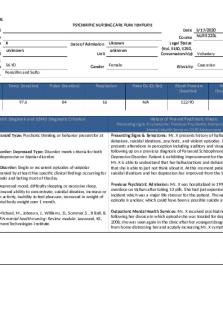Nursing review - Mental health 1-2-3-4-5-6 PDF

| Title | Nursing review - Mental health 1-2-3-4-5-6 |
|---|---|
| Course | Psych & Mental Hlth Nursing |
| Institution | Texas A&M International University |
| Pages | 42 |
| File Size | 1 MB |
| File Type | |
| Total Downloads | 58 |
| Total Views | 138 |
Summary
This document consists of summaries of every chapter mentioned. It is well organized and detailed....
Description
CHAPTER 1 MENTAL HEALTH AND MENTAL ILLNESS ➔
WHO describes health as → a state of complete physical, mental, and social well-being and not merely the absence of disease or infirmity.
➔
WHO defines mental health as a state of well-being in which each individual: ★ Able to recognize own potential ★ Cope with the normal stress of life ★ Work productively ★ Make a contribution to the community
➔ Attributes of mentally healthy people ➢ ➢ ➢ ➢ ➢ ➢ ➢ ➢ ➢ ➢ ➢ ➢ ➢
Think rationally Effective coping Communicate appropriately Self-Control Learn & productivity Self-awareness Grow emotionally Happiness & joy Be resilient Spiritual satisfaction Meaningful relationships Self-care Have a healthy self-esteem Realistic goals and reasonable function within the individual’s role
➔
Society’s definition of mental illness evolves over time.
➔
Def. Mental illness: refers to all psychiatric disorders that have definable diagnoses. ◆ Manifested in significant dysfunctions that may be related to: ● developmental ● biological ● psychological disturbances
MENTAL HEALTH CONTINUUM ➔
Mental health and mental illness can be conceptualized as points along a mental health continuum
➔
The distinguishing factor in mental illness is typically chronic or long-term impairments that range from moderate to disabling.
Part 1 of the picture ➔ On one end mental health ➔ Well-being: characterized by adequate to high-level functioning. Also, stress or discomfort from everyday life. ◆ Ex. Failed exam, sleepless night, mourning after the death of a loved one.
Part 2 of the picture ➔ as insomnia, lack of concentration, or loss of appetite may be felt. ➔ If distress increases or persists → professional help ➔ Problems tend to be temporary ➔ In this group: individuals with mild depression, generalized anxiety disorder, and attention deficit disorder Part 3 of the picture ➔ Altered thinking, mood, and behavior. ➔ In this group: depression, anxiety, schizophrenia
RISK AND PROTECTIVE FACTORS Individual attributes and behaviors ❖ Def. Individual attributes refer to characteristics that are both inborn and learned that make us who we are. ❖ Biological and genetic factors can also influence mental health. ➢ Ex. prenatal exposure to alcohol and oxygen deprivation → biological ➔
How do people adapt to tragedy, loss, trauma, and severe stress? → Resilience
➔
Resilience ◆ Def. Ability and capacity to secure resources needed to support the well-being ◆ People who are resilient are effective at regulating their emotions and not falling victim to negative, self-defeating thoughts. ◆ Characterized by: ● Optimism ● Sense of mastery ● Competence ● Process of adapting ◆ Essential to recovery ◆ Box 1.1 The resilience factor test
Social and economic circumstances ➔ ➔ ➔
This environment has the ability to affect mental health positively and negatively. Socioeconomic status dictates the sort of resources available to support mental health and reduce concerns over basic needs Educational advancement is a tremendous supporter of mental health by providing opportunities for a satisfying career, security, and economic benefits.
Environmental factors ➔ ➔
The overall environment that affects mental health relates to the political climate and cultural considerations. Predominant cultural beliefs, attitudes, and practices influence mental health.
Perceptions of mental health and mental illness ➔
Mental illness versus physical illness
➔ ➔
Mental: the brain Physical: the working of the brain
❖
Def. Stigma: the belief that the overall person is flawed, is characterized by social shunning, disgrace, and shame.
➔
There are no specific biological tests to diagnose most psychiatric disorders ◆ Some think that the root of most mental disorders lies in intercellular abnormalities. ● Altered brain function in schizophrenia, OCD, stress disorders, and depression.
➔ Nature vs Nurture
NOT REAL: ➔ Nature: “mania germ” ➔ Nurture: extremely unusual behaviors resulted from supernatural forces
➔ Diathesis-Stress Model ★ ★ ★ ★
The most accepted explanation for mental illness Diathesis: represents a biological predisposition Stress: represents environmental stress or trauma Nature vs. nurture: most psychiatric disorders result from a combination of genetic vulnerability and negative environmental stressors ★ Assertion: Most psychiatric disorders result from a combination of genetic vulnerability and negative environmental stressors
Social influences on mental health care (not study) ➔ Consumer Movement and Mental Health Recovery ❖
Groups of people with mental illnesses—frequently called mental health consumers—began to advocate for their rights and fought against discrimination and forced treatment. ❖ In 1979 people with mental illnesses and their families formed a nationwide advocacy group, the National Alliance on Mental Illness (NAMI). ❖ The consumer movement also promoted the concept of recovery, a new and an old idea. ➢ Def. Recovery “A process of change through which individuals improve their health and wellness, live a self-directed life, and strive to reach their full potential.” ➢ Ex. On the book
➔ The decade of the brain (1990) ➔
The goal: to make legislators and the public aware of the advances that had been made in neuroscience and brain research.
➔ Surgeon General’s Report on Mental Health ➔ ➔
The first Surgeon General’s report on the topic of mental health was published in 1999. The two most important messages from this report were that ◆ (1) mental health is fundamental to overall health ◆ (2) there are effective treatments.
➔ Human genome project ➔ ➔
13-year project The project has strengthened biological and genetic explanations for psychiatric conditions. ◆ Identify the approximately 20,000 to 25,000 genes in human DNA. ◆ Determine the sequences of the 3 billion chemical base pairs that make up human DNA. ◆ Store this information in databases. ◆ Improve tools for data analysis. ◆ Address the ethical, legal, and social issues that may arise from the project.
➔ President’s New Freedom Commission on Mental Health ➔ ➔
The report stated that the system of delivering mental healthcare in America was in shambles. The commission advocated for early diagnosis and treatment, adoption of principles of recovery, and increased assistance in helping people find housing and work.
➔ Institute of Medicine
➔ ➔ ➔ ➔ ➔
❖
The Improving the Quality of Health Care for Mental and Substance-Use Conditions: Quality Chasm Series was released in 2005. The report encouraged healthcare workers to focus on safe, effective, patient-centered, timely, efficient, and equitable care. BOX 1.2 Goals for a Transformed Mental Health System in the United The Future of Nursing: Focus on Education. This report contends that the old way of training nurses is not adequate for the 21st century’s complex requirements. They recommended that nurses be trained in leadership, health policy, system improvement, research, and teamwork. Quality and Safety Education for Nurses (QSEN; pronounced Q-sen) → Recommendations from both documents ➢ Support the education of future nurses who possess the knowledge, skills, and attitudes to continuously improve the safety and quality of healthcare. ★ Patient-centered care ★ Teamwork and collaboration ★ Evidence-based practice ★ Quality improvement ★ Safety ★ Informatics
➔ Brain Research through Advancing Innovative Neurotechnologies (BRAIN) Initiative ➔
The goal → to uncover news ways to prevent, treat, and cure psychiatric disorders, epilepsy, and traumatic brain injury.
➔ Research Domain Criteria (RDoC) Initiative ➔
Challenges researchers to seek causes for mental disorders at the molecular level.
LEGISLATION AND MENTAL HEALTH FUNDING Mental health parity ➔ ➔
Parity = equivalence or equal treatment Mental Health Parity Act (1996) ◆ This legislation required insurers that provide mental health coverage to offer annual and lifetime benefits at the same level provided for medical/surgical coverage. ◆ Required insurance companies to provide equal treatment coverage for psychiatric disorders
Patient Protection and Affordable Care Act of 2010 ➔ ➔
Parity laws do not require health plans to cover psychiatric care. The parity laws only applied to large insurers.
➔
This act: ◆ Coverage for most uninsured Americans through expanded Medicaid eligibility (for very poor) ◆ Created health insurance exchanges to offer more choices ◆ “Insurance mandate” for coverage. A requirement that people without coverage obtain it.
EPIDEMIOLOGY OF MENTAL DISORDERS ➔
Def. Epidemiology: quantitative study of the distribution of mental disorders ◆ Identify high-risk groups ◆ Identify high-risk factors
★ ★ ★
Incidence = number of new cases in a given time (usually annually) Prevalence = total number of cases regardless of when they began Lifetime risk = risk that one will develop a disease in the course of a lifetime
❖
Comorbid condition → the simultaneous existence of two or more disorders
Prevalence (Examples) Major depressive disorder: Leading cause of disability in U.S. at 6.7% prevalence over 12 months Schizophrenia: 1.1% prevalence over 12 months; affects men and women equally Panic disorder: 2.7% prevalence over 12 months; typically begins in adolescence; 1 in 3 develop agoraphobia Generalized anxiety: 3.1% prevalence over 12 months; risk is highest between childhood and middle age
Clinical epidemiology ➔
Examines health and illness at the population level. ◆ Studies of the natural history of an illness ◆ Studies of diagnostic screening tests ◆ Observational and experimental studies of interventions used to treat people with the illness or symptoms
➔
Analysis of epidemiological studies can reveal the frequency with which psychological symptoms appear together with physical illness.
Classification of mental disorders ➔ ➔
Nursing care is based on responses to illness ( more about the symptoms) RNs treat problems associated with depression (insomnia or hopeleness)
❖
There are two major classification systems used in the United States: ➢ The Diagnostic and Statistical Manual, Fifth Edition (DSM-5)/(DSM-V). It is the dominant method in the US. ➢ The International Classification of Disease, Tenth Revision, Clinical Modification (ICD-10-CM)
★ The DSM-5/DSM-V ○ ○ ○ ○ ○
Diagnostic and Statistical Manual (DSM) 5th edition It describes criteria for 157 disorders. It is based on specific criteria influenced by multiprofessional clinical fields The DSM also serves as a tool for collecting epidemiological statistics about the diagnosis of psychiatric disorders. DSM classifies disorders
★ The ICD--CM ○ ○
International Classification of Diseases (ICD), 10th revision Clinical descriptions of mental and behavior disorders ■ 2 broad classification ■ subclassifications
Psychiatric mental health nursing ➔ ➔ ➔ ➔
Promoting mental health through the assessment, diagnosis, and treatment of behavioral problems, mental disorders, and comorbid conditions across the lifespan. Use nursing, psychosocial, neurobiological theories and research Work with people throughout the life span Employed in a variety of settings and among varied populations
Classification of Nursing Diagnoses, Outcomes, and Interventions NANDA-I, NOC, and NIC ➔
The North American Nursing Diagnosis Association International (NANDA-I) ◆ Provides standardized nursing diagnoses ➔ Nursing Outcomes Classification (NOC) ◆ Source of standardized outcomes, definitions of these outcomes, and measuring scales ➔ Nursing Interventions Classification (NIC)
◆ used to standardize, define, and measure nursing care. ◆ Identifies seven domains of nursing intervention
Levels of Psychiatric Nursing Practice ➔
Psychiatric nurses are qualified to practice at two levels, basic and advanced, depending on educational preparation.
Basic level ➔ ➔
Qualified to work in most any general or specialty area. Psychiatric mental health registered nurse (PMH-RN) ◆ chooses to work in the specialty of psychiatric-mental health nursing. ➔ 2 years full-time work, 2000 clinical hours, 30 hours continuing education, followed by certification exam to add “BC” to the RN title (RN-BC)
Advanced practice ➔
Psychiatric-mental health advanced practice registered nurse (PMH-APRN) ◆ Master of Science in Nursing (MSN) or Doctor of Nursing Practice (DNP) in psychiatric nursing.
Future Issues for Psychiatric-Mental Health Nurses ➔ ➔ ➔ ➔ ➔ ➔
Education Aging population Cultural diversity Science, technology, and electronic health care Patient advocacy - direct & indirect Legislative involvement
CHAPTER 2 THEORIES AND THERAPIES PSYCHOANALYTIC THEORIES AND THERAPIES Psychoanalytic Theory - FREUD ➔ ➔
He introduced a theory of personality structure, levels of awareness, anxiety, the role of defense mechanisms, and the stages of psychosexual development. Freud believed that the majority of mental disorders resulted from unresolved issues that originated in childhood.
Levels of Awareness Conscious ❖
It contains all the material a person is aware of at any one time including: ➢ perceptions, memories, thoughts, fantasies, and feelings.
Preconscious ❖
It contains material that can be retrieved rather easily through conscious effort.
Unconscious ❖ It includes all repressed memories, passions, and unacceptable urges lying deep below the surface. ❖ Memories and emotions associated with trauma ❖ The individual is usually unable to retrieve unconscious material without the assistance of a trained therapist.
Personality Structure
Id ❖ ❖ ❖ ❖
At birth, we are all id. It is totally unconscious and impulsive. It is the source of all drives, instincts, reflexes, and needs. Lacks the ability to problem solve and is illogical.
❖
If the id is too powerful, the person will lack control over impulses.
❖ ❖ ❖
Pleasure principle Reflex action Primary process
❖ ❖ ❖
Developed within the first few years of life It resides in all levels of awareness The problem solver and reality tester
Ego
Superego ❖ ❖ ❖ ❖
Developed between the ages of 3 and 5 It resides in all levels of awareness Represents the moral component of personality. It consists of the conscience
❖
If the superego is too powerful, the person may be self-critical and suffer from feelings of inferiority.
Defense Mechanisms and Anxiety ❖
Two common features: ➢ (1) they all (except suppression) operate on an unconscious level ➢ (2) they deny, falsify, or distort reality to make it less threatening.
Freud’s Psychosexual Stages of Development (5) ❖ ❖ ❖ ❖ ❖
Oral (0 to 1 year) Anal (1 to 3 years) ➢ Fixation state? Phallic (oedipal) (3 to 6 years) Latency (6 to 12 years) Genital (12 years and beyond)
TABLE 2. 1
Psychoanalytic Therapy/CLASSICAL PSYCHOANALYSIS ❖ ❖ ❖
Seldom used today Intrapsychic conflict no longer considered to be the cause of all mental illness Valid tools and concepts ➢ Transference ■ unconscious feelings that the patient has toward a healthcare worker that were originally felt in childhood for a significant other. ● “you remind me exactly of my sister” ➢ Countertransference ■ unconscious feelings that the healthcare worker has toward the patient.
Psychodynamic Therapy ❖
Psychodynamic therapy follows the psychoanalytic model by using many of the tools of psychoanalysis such as free association, dream analysis, transference, and countertransference. ❖ The therapist is oriented toward the here and now and not oriented towards the origins of conflicts
INTERPERSONAL THEORIES AND THERAPIES Interpersonal Theory - Sullivan ❖ ❖ ❖
Human beings are driven by the need for interaction. He viewed loneliness as the most painful human condition. The purpose of all behavior is to get needs met through interpersonal interactions and to reduce or avoid anxiety.
❖
Foundation for Hildegard Peplauʼs theory ➢ – Participant observer ■ Mutuality ■ Respect for the patient ■ Unconditional acceptance ■ Empathy
Interpersonal Therapy ❖ ❖
An effective short-term therapy. The goal of interpersonal therapy is to reduce or eliminate psychiatric symptoms (particularly depression) by improving interpersonal functioning and satisfaction with social relationships. ❖ 3 types of problems that respond well to this therapy: ➢ Grief and loss ➢ Interpersonal disputes ➢ Role transition
Implications of Interpersonal Theory to Nursing (she) Peplau’s Theory of Interpersonal Relationships ❖ ❖
The nurse helps patients make positive changes in their healthcare status and well-being. Nurses are both participants and observers in therapeutic conversations. Self-awareness.
❖
Described the effects of different levels of anxiety (mild, moderate, severe, and panic) on perception and learning Promoted interventions to lower anxiety Aim to improve patient’s ability to think and function at more satisfactory levels
❖ ❖
TABLE 2.2 nursing theorists and their contributions
BEHAVIORAL THEORIES AND THERAPIES ➔ ➔
Personality simply consists of learned behaviors. The behavior is influenced by conditioning. ◆ Def. Pairing a behavior with a condition that reinforces or diminishes the behavior’s occurrence.
Classical Conditioning Theory - Ivan Pavlov ➔
➔
❖
He observed dogs’ behaviors ◆ A neutral stimulus (a bell) was repeatedly paired with another stimulus (food that triggered salivation), eventually, the sound of the bell alone could elicit salivation in the dogs. In humans ◆ A boy becoming ill after eating spoiled coleslaw. Later in life, he feels nauseated whenever he smells coleslaw. Classical conditioned responses are involuntary—not under conscious personal control—and are not spontaneous choices.
Behavioral theory - John Watson ❖ ❖
He developed behaviorism Personality traits and responses—adaptive and maladaptive—were socially learned through classical conditioning.
❖
Experiment ➢ Watson made a loud noise with a hammer every time an infant reached for a white rat. ➢ The infant became terrified at the sight of white fur or hair, even in the absence of loud noise.
Operant Conditioning Theory - B.F Skinner ❖
Operant conditioning: a method of learning that occurs through rewards and punishment for voluntary behavior. ➢ Reinforcement: causes a behavior to occur more frequently ■ Positive reinforcement ● When a hungry rat pressed the lever, it would receive a food pellet. ■ Negative reinforcement ● A rat had an electrical charge on the grid under his feet. ● He learned to go straight to the lever to eliminate the shock. ➢ Punishment: causes a behavior to occur less frequently ■ Speeding ticket ➢ Extinction (absence of reinforcement): withholding a reward that has become habitual. ■ If a person tells a joke and no one laughs
Behavioral Therapy ❖ ❖ ❖
Based on the assump...
Similar Free PDFs

Uworld Mental Health Nursing
- 168 Pages

Mental Health Final Review
- 44 Pages

Mental health Jeopardy Review
- 2 Pages
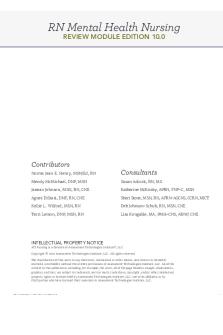
ebook for mental health nursing
- 219 Pages
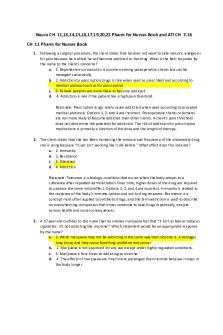
ATI TEST - mental health nursing
- 38 Pages

ATI Mental Health Final Review
- 12 Pages

Exam 3 Review– Mental Health
- 4 Pages

Mental Health Final Exam review
- 41 Pages
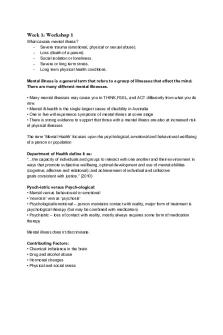
Nursing and Mental Health 1 Notes
- 62 Pages
Popular Institutions
- Tinajero National High School - Annex
- Politeknik Caltex Riau
- Yokohama City University
- SGT University
- University of Al-Qadisiyah
- Divine Word College of Vigan
- Techniek College Rotterdam
- Universidade de Santiago
- Universiti Teknologi MARA Cawangan Johor Kampus Pasir Gudang
- Poltekkes Kemenkes Yogyakarta
- Baguio City National High School
- Colegio san marcos
- preparatoria uno
- Centro de Bachillerato Tecnológico Industrial y de Servicios No. 107
- Dalian Maritime University
- Quang Trung Secondary School
- Colegio Tecnológico en Informática
- Corporación Regional de Educación Superior
- Grupo CEDVA
- Dar Al Uloom University
- Centro de Estudios Preuniversitarios de la Universidad Nacional de Ingeniería
- 上智大学
- Aakash International School, Nuna Majara
- San Felipe Neri Catholic School
- Kang Chiao International School - New Taipei City
- Misamis Occidental National High School
- Institución Educativa Escuela Normal Juan Ladrilleros
- Kolehiyo ng Pantukan
- Batanes State College
- Instituto Continental
- Sekolah Menengah Kejuruan Kesehatan Kaltara (Tarakan)
- Colegio de La Inmaculada Concepcion - Cebu

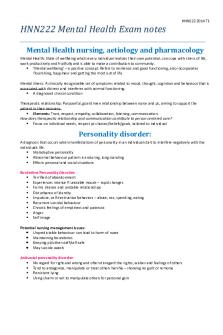

![Mental Health Review Questions[ 9993]](https://pdfedu.com/img/crop/172x258/m52yo19xkw3e.jpg)

